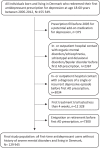Early labor force exits in patients with treatment-resistant depression: an assessment of work years lost in a Danish nationwide register-based cohort study
- PMID: 33282176
- PMCID: PMC7682207
- DOI: 10.1177/2045125320973791
Early labor force exits in patients with treatment-resistant depression: an assessment of work years lost in a Danish nationwide register-based cohort study
Abstract
Background: Depression is one of the leading causes of premature workforce exit in many Western countries, but little is known about the extent to which treatment-resistance reduces number of work-years. We compared the risk of premature workforce exit among patients with treatment-resistant depression (TRD) relative to non-TRD patients and estimated work years lost (WYL) before scheduled retirement age.
Methods: The study population, identified in the Danish National Prescription Registry, included all individuals born and living in Denmark who redeemed their first antidepressant (AD) prescription for depression at age 18-60 years between 2005 and 2012. TRD was defined as failure to respond to at least two different treatment trials. Premature workforce exit was measured using disability pension records. We used Cox regression to estimate the hazard ratio (HR) for premature workforce exit in TRD relative to non-TRD patients, adjusting for calendar year, psychiatric and somatic comorbidity, and educational level. Differences in WYL in patients with TRD and all depression patients were estimated through a competing risks model.
Results: Out of the total sample of patients with depression (N = 129,945), 7478 (5.75%) were classified as having TRD. During follow up, 17% of patients with TRD and 8% of non-TRD patients received disability pension, resulting in a greater than three-fold larger risk of premature workforce exit [adjusted HR (aHR) 3.23 95% confidence interval (CI) 3.05-3.43]. The TRD group lost on average six work-years (95% CI 5.64-6.47) more than the total sample due to early labor force exit. The association between TRD and age at premature workforce exit was inversely U-shaped; the hazard rate of premature workforce exit for patients with TRD compared with non-TRD patients was highest in the age groups 31-35, 36-40, and 41-45 years.
Conclusion: Patients with TRD constitute a small group within depression patients, but contribute disproportionally to societal costs due to premature workforce exit at a young age.
Keywords: antidepressant treatment; disability pension; labor force exit; treatment-resistant depression; work years lost.
© The Author(s), 2020.
Conflict of interest statement
Conflict of interest statement: The authors declare that there is no conflict of interest.
Figures



References
-
- Gustavsson A, Svensson M, Jacobi F, et al. Cost of disorders of the brain in Europe 2010. Eur Neuropsychopharmacol 2011; 21: 718–779. - PubMed
-
- Greenberg PE, Fournier A-A, Sisitsky T, et al. The economic burden of adults with major depressive disorder in the United States (2005 and 2010). J Clin Psychiatry 2015; 76: 155–162. - PubMed
-
- Sobocki P, Jonsson B, Angst J, et al. Cost of depression in Europe. J Ment Health Policy Econ 2006; 9: 87–98. - PubMed
-
- Sobocki P, Lekander I, Borgstrom F, et al. The economic burden of depression in Sweden from 1997 to 2005. Eur Psychiatry 2007; 22: 146–152. - PubMed
-
- OECD. Sickness, disability and work: breaking the barriers [Internet]. OECD, https://www.oecd-ilibrary.org/social-issues-migration-health/sickness-di... (2010, accessed 14 November 2019).
LinkOut - more resources
Full Text Sources

